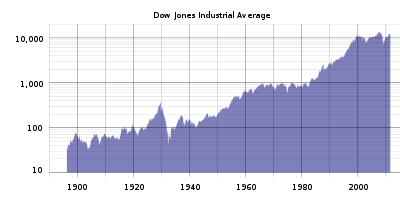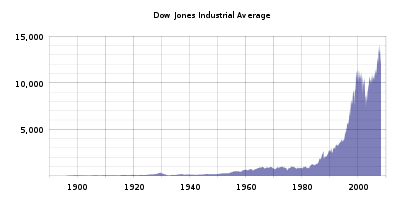- Closing milestones of the Dow Jones Industrial Average
-
This article is a summary of the closing milestones of the Dow Jones Industrial Average, a United States stock market index. Since opening at 40.94 on May 26, 1896, the Dow Jones Industrial Average has increased steadily, despite several periods of decline.
Contents
Milestone highs and lows
 Logarithmic graph of the DJIA from 1896 through Oct 2009
Logarithmic graph of the DJIA from 1896 through Oct 2009
Like most other stock market indices, the Dow undergoes periods of general increase and general declines or stagnation. A bull market is a term denoting a period of price increases, while a bear market denotes a period of declines. Wall Street generally considers a bear market in session when the main stock market index is more than 20 percent below its all-time high.[citation needed]
There are two types of bull markets. A secular bull market is a period in which the stock market index is continually reaching all-time highs with only brief periods of correction, as during the 1990s, and can last upwards of 15 years. A cyclical bull market is a period in which the stock market index is reaching 52-week or multi-year highs and may briefly peak at all-time highs before a rapid decline, as in the early 1970s. It usually occurs within relatively longer bear markets and lasts about three years.
The following are the secular bull and bear markets experienced by the Dow since its inception:
- 1896–1929: Bull market. In the summer of 1896 the Dow sheds 30% to set an all-time low of 28.48, but quickly erases its losses, and eventually grows to a closing high of 381.17 (theoretical intra-day high of 386.1) on September 3, 1929.
- 1929–1949: Bear market. The stock market crash of 1929 precedes the Great Depression. The Dow plunges to 41.22 (theoretical intra-day low of 40.56) on July 8, 1932, thus erasing 36 years of gains. Although cyclical bull markets occur in the 1930s and 1940s, the index would take 22 years to surpass its previous highs.
- 1949–1966: Bull market. The Dow posts impressive growth in the booming economy following the Second World War. Starting from about 150 in June 1949, when P/E ratios reach multi-decade lows, the index ends just five points below 1,000 on February 9, 1966.
- 1967–1982: Bear market. Traders deal with a stagnant economy in an inflationary monetary environment. The Dow enters two long downturns in 1970 and 1974; during the latter, it falls nearly 45% to the bottom of a 20-year range.
- 1982–2000: Bull market. The Dow experiences its most spectacular rise in history. From a meager 777 on August 12, 1982, the index grows more than 1,500% to close at 11,722.98 by January 14, 2000, without any major reversals except for a brief but severe downturn in 1987, which includes the largest daily percentage loss in Dow history.
- 2000–present: Bear market. The index meanders and then plunges to a closing low of 7,286.27 on October 9, 2002. A cyclical bull peak above the 14,000 level, reached exactly five years later, does not surpass the inflation-adjusted 2000 high. A renewed bear is recognized in summer 2008 and multiple volatility records are set that autumn. Another acute phase in early 2009 brings the index to new 12½ year lows around 6,600, for a total loss of 53% in less than 18 months.
Incremental closing milestones
The following is a list of the milestone closing levels of the Dow Jones Industrial Average, in 100-point increments.
Milestone Closing Level Date first achieved The first bull market (1896–1929) 100 100.25 January 12, 1906 200 200.93 December 19, 1927 300 300.00 December 31, 1928 The post-World War II boom (1949–1966) 381.171 382.74 November 23, 1954 400 401.97 December 29, 1954 500 500.24 March 12, 1956 600 602.21 February 20, 1959 700 705.52 May 17, 1961 800 800.14 February 28, 1964 900 900.95 January 28, 1965 The 1970s bear market (1967–1982) 1,0002 1,003.16 November 14, 1972 The 1980s bull market (1982–1987) 1,100 1,121.81 February 24, 1983 1,200 1,209.46 April 26, 1983 1,300 1,304.88 May 20, 1985 1,400 1,403.44 November 6, 1985 1,500 1,511.70 December 11, 1985 1,600 1,600.69 February 6, 1986 1,700 1,713.99 February 27, 1986 1,800 1,804.24 March 20, 1986 1,900 1,903.54 July 1, 1986 2,000 2,002.25 January 8, 1987 2,100 2,102.50 January 19, 1987 2,200 2,201.49 February 5, 1987 2,300 2,333.52 March 20, 1987 2,400 2,405.54 April 6, 1987 2,500 2,510.04 July 17, 1987 2,600 2,635.84 August 10, 1987 2,700 2,700.57 August 17, 1987 The 1990s bull acceleration (1990–2000) 2,800 2,810.15 January 2, 1990 2,900 2,900.97 June 1, 1990 3,000 3,004.46 April 17, 1991 3,100 3,101.52 December 27, 1991 3,200 3,201.48 January 3, 1992 3,300 3,306.13 April 14, 1992 3,400 3,413.21 June 1, 1992 3,500 3,500.03 May 19, 1993 3,600 3,604.86 August 18, 1993 3,700 3,710.77 November 16, 1993 3,800 3,803.88 January 6, 1994 3,900 3,914.48 January 21, 1994 4,000 4,003.33 February 23, 1995 4,100 4,138.67 March 24, 1995 4,200 4,201.61 April 4, 1995 4,300 4,303.98 April 24, 1995 4,400 4,404.62 May 10, 1995 4,500 4,510.69 June 16, 1995 4,600 4,615.23 July 5, 1995 4,700 4,702.73 July 7, 1995 4,800 4,801.80 September 14, 1995 4,900 4,922.75 November 15, 1995 5,000 5,023.55 November 21, 1995 5,100 5,105.56 November 29, 1995 5,200 5,216.47 December 13, 1995 5,300 5,304.98 January 29, 1996 5,400 5,405.06 February 1, 1996 5,500 5,539.45 February 8, 1996 5,600 5,600.15 February 12, 1996 5,700 5,748.82 May 20, 1996 5,800 5,838.52 September 13, 1996 5,900 5,904.90 October 1, 1996 6,000 6,010.00 October 14, 1996 6,100 6,177.71 November 6, 1996 6,200 6,206.04 November 7, 1996 6,300 6,313.00 November 14, 1996 6,400 6,430.02 November 20, 1996 6,500 6,547.79 November 25, 1996 6,600 6,600.66 January 7, 1997 6,700 6,703.09 January 10, 1997 6,800 6,833.10 January 17, 1997 6,900 6,961.63 February 12, 1997 7,000 7,022.44 February 13, 1997 7,100 & 7,200 7,214.49 May 5, 1997 7,300 7,333.55 May 15, 1997 7,400 7,435.78 June 6, 1997 7,500 7,539.27 June 10, 1997 7,600 & 7,700 7,711.47 June 12, 1997 7,800 7,895.81 July 3, 1997 7,900 7,962.31 July 8, 1997 8,000 8,038.88 July 16, 1997 8,100 8,116.93 July 24, 1997 8,200 8,254.89 July 30, 1997 8,300 8,314.55 February 11, 1998 8,400 8,451.06 February 18, 1998 8,500 8,545.72 February 27, 1998 8,600 8,643.12 March 10, 1998 8,700 8,718.85 March 16, 1998 8,800 8,803.05 March 19, 1998 8,900 8,906.43 March 20, 1998 9,000 9,033.23 April 6, 1998 9,100 9,110.02 April 14, 1998 9,200 9,211.84 May 13, 1998 9,300 9,328.19 July 16, 1998 9,400 & 9,500 9,544.87 January 6, 1999 9,600 9,643.37 January 8, 1999 9,700 9,736.08 March 8, 1999 9,800 9,897.44 March 11, 1999 9,900 9,958.77 March 15, 1999 10,000 10,006.78 March 29, 1999 10,100 10,197.70 April 8, 1999 10,200 & 10,300 10,339.51 April 12, 1999 10,400 10,411.66 April 14, 1999 10,500 10,581.42 April 21, 1999 10,600 & 10,700 10,727.18 April 22, 1999 10,800 10,831.71 April 27, 1999 10,900 & 11,000 11,014.70 May 3, 1999 11,100 11,107.19 May 13, 1999 11,200 11,200.98 July 12, 1999 11,300 11,326.04 August 25, 1999 11,400 11,405.76 December 23, 1999 11,500 11,522.56 January 7, 2000 11,600 & 11,700 11,722.98 January 14, 2000 The mid-2000s cyclical bull (2003–2007) 11,722.98 11,727.34 October 3, 2006 11,800 11,850.61 October 4, 2006 11,900 11,947.70 October 12, 2006 12,000 12,011.73 October 19, 2006 12,100 12,116.91 October 23, 2006 12,200 12,218.01 November 14, 2006 12,300 12,305.82 November 16, 2006 12,400 12,416.76 December 14, 2006 12,500 12,510.57 December 27, 2006 12,600 12,621.77 January 24, 2007 12,700 12,741.86 February 14, 2007 12,800 12,803.84 April 18, 2007 12,900 12,961.98 April 20, 2007 13,000 13,089.89 April 25, 2007 13,100 13,105.50 April 26, 2007 13,200 13,211.88 May 2, 2007 13,300 13,312.97 May 7, 2007 13,400 13,487.53 May 16, 2007 13,500 13,556.53 May 18, 2007 13,600 13,633.08 May 30, 2007 13,700 & 13,800 13,861.73 July 12, 2007 13,900 13,907.25 July 13, 2007 14,000 14,000.41 July 19, 2007 14,100 14,164.53 October 9, 2007 1This was the Dow's close at the peak of the 1929 bull market, a level that the Dow would not see again for 25 years.
2The Dow first exceeded 1000 during the trading day on January 18, 1966, but dropped back before closing that day. It would be nearly 7 years later before it closed above 1000 for the first time.Record highs and decade lows
Closing: 14,164.53 Tuesday, October 9, 2007 6,547 Monday, March 9, 2009 Intra-day Actual: 14,198.10 Thursday, October 11, 2007 6,469 Friday, March 6, 2009 Intra-day Theoretical: 14,279.96 Thursday, October 11, 2007 6,443 Friday, March 6, 2009 See also
- List of largest daily changes in the Dow Jones Industrial Average
- Stock market bubble
- Stock market crash
External links
Categories:
Wikimedia Foundation. 2010.

